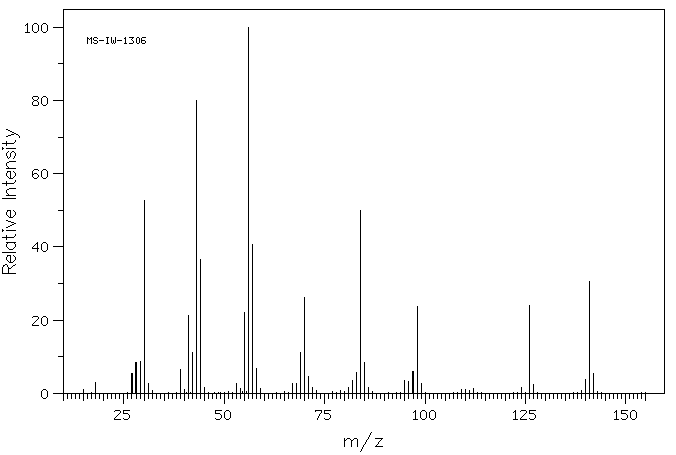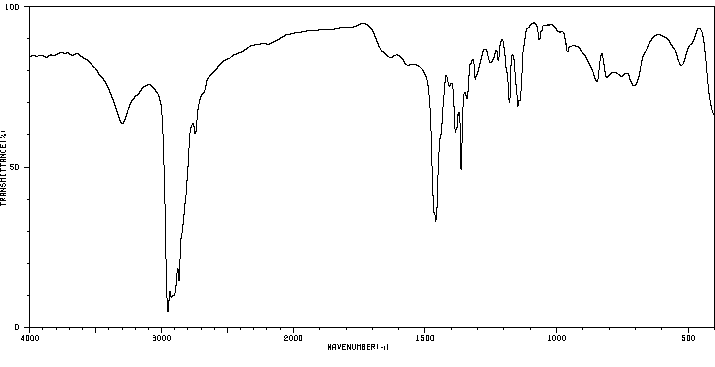3,3,5-trimethylhexahydroazepine | 35466-89-8
中文名称
——
中文别名
——
英文名称
3,3,5-trimethylhexahydroazepine
英文别名
1H-Azepine, hexahydro-3,3,5-trimethyl-;3,3,5-trimethylazepane
CAS
35466-89-8
化学式
C9H19N
mdl
MFCD00006935
分子量
141.257
InChiKey
YBRAVTNTXVZNMD-UHFFFAOYSA-N
BEILSTEIN
——
EINECS
——
-
物化性质
-
计算性质
-
ADMET
-
安全信息
-
SDS
-
制备方法与用途
-
上下游信息
-
文献信息
-
表征谱图
-
同类化合物
-
相关功能分类
-
相关结构分类
计算性质
-
辛醇/水分配系数(LogP):2.3
-
重原子数:10
-
可旋转键数:0
-
环数:1.0
-
sp3杂化的碳原子比例:1.0
-
拓扑面积:12
-
氢给体数:1
-
氢受体数:1
反应信息
-
作为反应物:描述:3,3,5-trimethylhexahydroazepine 在 盐酸 作用下, 以 乙醇 、 苯 为溶剂, 反应 14.0h, 生成 1-Phenyl-3-(3,3,5-trimethylazepan-1-yl)propan-1-one参考文献:名称:Hypolipidemic effects of α, β, and γ-alkylaminophenone analogs in rodents摘要:A number of N-substituted beta-alkylaminophenone derivatives including two alpha- and two gamma-alkylaminophenone analogs were synthesized and investigated for hypolipidemic activity in mice at 8 mg/kg/day ip. Most of these analogs were found to be significantly more active than lovastatin and clofibrate. N-Phenylpiperazinopropiophenone 16 was one of the best derivatives, lowering serum cholesterol levels 41% and serum triglyceride levels 48% after 16 days of drug administration in CF1 mice. In Sprague-Dawley rats, N-phenylpiperazinopropiophenone at 8 mg/kg/day orally also demonstrated more potent hypolipidemic activity than clofibrate, gemfibrozil, and lovastatin at their therapeutic dosage. It significantly reduced tissue cholesterol and triglyceride levels in the aorta wall tissue and lowered the cholesterol and triglyceride levels in chylomicron, very low density lipid (VLDL) and low density lipid (LDL) fractions, while it significantly elevated the cholesterol levels in high density lipid (HDL) fraction. This compound also proved to be active in lowering both cholesterol and triglyceride levels in hyperlipidemic mice and rats induced with atherogenic diet. In vitro liver acetyl coenzyme A (CoA) synthetase, 3-hydroxy-3-methyl glutaryl (HMG) CoA reductase, acyl CoA cholesterol acyl transferase (ACAT), sn-glycerol-3-phosphate acyltransferase, phosphatidylate phosphohydrolase, and hepatic lipoprotein lipase activities were significantly inhibited by N-phenylpiperazinopropiophenone from 25 to 100 mu M.DOI:10.1016/0223-5234(96)80365-5
文献信息
-
Synthesis and Evaluation of (Piperidinomethylene)bis(phosphonic acid) Derivatives as Anti-osteoporosis Agents.作者:Mitsuo MIMURA、Mitsuo HAYASHIDA、Kiyoshi NOMIYAMA、Satoru IKEGAMI、Yasuhito IIDA、Makoto TAMURA、Yoshiyuki HIYAMA、Yoshitaka OHISHIDOI:10.1248/cpb.41.1971日期:——Some (piperidinomethylene)bis(phosphonic acid) derivatives were prepared and their activity to inhibit a rise in serum calcium induced by parathyroid hormone in thyroparathyroidectomised rats was evaluated. Several (4-alkylidene-, 4,4-dialkyl-, or 4-alkyl-4-halopiperidinomethylene)bis(phosphonic acid) derivatives showed considerable inhibitory activity. But compounds having aromatic and polar substituents
-
Novel 3-phenylprop-2-ynylamines as inhibitors of mammalian squalene epoxidaseElectronic supplementary information (ESI) available: Proton NMR spectra for the intermediate piperidines 56–60 and acetylenes 63-81 and 85,86. See http://www.rsc.org/suppdata/ob/b2/b209165h/作者:David L. Musso、Morris J. Clarke、James L. Kelley、G. Evan Boswell、Grace ChenDOI:10.1039/b209165h日期:2003.1.30The synthesis of a novel series of 3-phenylprop-2-ynylamines as selective mammalian squalene epoxidase inhibitors is described. Structure–activity relationship studies led to the discovery of compound 19, 1-[3-(3,5-dichlorophenyl)prop-2-ynyl]-3-methylpiperidine hydrochloride with an IC50 of 2.8 ± 0.6 µM against rat liver squalene epoxidase. Against 23 strains of fungal squalene epoxidase compound 19 was found to be inactive.
-
Substituted n-(indole-2-carbonyl)-glycinamides and derivatives as申请人:Pfizer, Inc.公开号:US06107329A1公开(公告)日:2000-08-22Compounds of Formula (1) wherein R.sub.6 is carboxy, (C.sub.1 -C.sub.8)alkoxycarbonyl, benzyloxycarbonyl, C(O)NR.sub.8 R.sub.9 or C(O)R.sub.12 as glucogen phosphorylase inhibitors, pharmaceutical compositions containing such inhibitors and the use of such inhibitors to treat diabetes, hyperglycemia, hypercholesterolemia, hypertension, hyperinsulinemia, hyperlipidemia, atherosclerosis and myocardial ischemia in mammals.
-
Synthesis and cytotoxic activity of α-santonin amino-derivatives作者:S. G. Klochkov、S. V. Afanas’eva、A. N. Pushin、G. K. Gerasimova、N. K. Vlasenkova、Yu. N. BulychevDOI:10.1007/s10600-010-9499-3日期:2009.11Previously unknown amino-derivatives of the natural sesquiterpene lactone α-santonin were synthesized. The activity of the products against several human tumor-cell lines was studied.
-
Studies on pyrrolidinones. Synthesis of some bioisosteres of 3,3,5-trimethylcyclohexyl pyroglutamate作者:Benoǐt Rigo、Claude LaruelleDOI:10.1002/jhet.5570340142日期:1997.1The synthesis of new N-(4-chlorobenzyl) and N-(4-chlorobenzoyl)pyroglutamic esters and amids whose the structure conserves the main structural features of the cholesterol lowering agent crilvastatin is described.
表征谱图
-
氢谱1HNMR
-
质谱MS
-
碳谱13CNMR
-
红外IR
-
拉曼Raman
-
峰位数据
-
峰位匹配
-
表征信息
同类化合物
黄莲素
铜(2+)9,23-二(丁基氨磺酰)-2,16-二[(2-乙基己基)氨磺酰]酞菁-29,31-二负离子
西替地尔
苯甲酯庚
美索庚嗪
美普他酚
缩氨基硫脲H
禾草敌-亚砜
禾草敌
碘正离子,(4-丁基苯基)-1-戊炔-1-基-
盐酸美普他酚
甲基3-(2-硫代-1-氮杂环庚基)丙酸酯
环己亚胺
氮杂环庚烷-4-羧酸甲酯盐酸盐
氮杂环庚烷-4-羧酸乙酯
氮杂环庚烷-3-酮盐酸盐
氮杂环庚烷-3-羧酸乙酯盐酸盐
氮杂环庚烷-3-基甲醇盐酸盐
氮杂环庚烷-3-基-甲基-胺
氮杂环庚烷-1-二硫代甲酸
氮杂环庚-4-酮
氮杂烷-1,3-二羧酸 1-叔丁酯
氮杂-1-基(环戊基)乙腈
氨基甲酸,N-(六氢-1H-氮杂环庚烯-3-基)-,1,1-二甲基乙基酯
氨基甲二硫酸,(六氢-1H-吖庚英-1-基)-,1-乙酰基-2-羰基丙基酯
吖庚环-1-基(苯基)乙酰腈
叔-丁基4-氨基-5-甲基吖庚环-1-甲酸基酯
叔-丁基4-亚甲基氮杂环庚烷-1-羧酸酯
叔-丁基2-氧亚基-7-氮杂螺[3.6]癸烷-7-甲酸基酯
叔-丁基1-(羟甲基)-6-氮杂螺[2.6]壬烷-6-甲酸基酯
双六亚甲基脲
十氢吡嗪并[1,2-a]氮杂卓
六甲烯亚氨基乙腈
六甲烯二硫代]氨基甲酸 六甲基铵盐
六氢化-1H-4-氮杂卓胺
六氢-alpha-甲基-1H-氮杂卓-1-丙酸甲酯盐酸盐(1:1)
六氢-alpha-甲基-1H-氮杂卓-1-丙酸甲酯
六氢-4-(羟基甲基)-1,1-二甲基-4-苯基-1H-氮杂卓鎓溴化物(1:1)
六氢-3,3,5-三甲基-1H-氮杂ze盐酸盐
六氢-2-甲基-1H-氮杂卓盐酸盐
六氢-2-[(3-甲基-4-吡啶)甲基]-1H-氮杂卓
六氢-1H-氮杂卓-4-醇盐酸盐
六氢-1H-氮杂卓-4-醇
六氢-1H-氮杂卓-4-羧酸甲酯
六氢-1H-氮杂卓-1-羧酸乙酯
六氢-1H-氮杂卓-1-硫代羧酸
六氢-1H-氮杂卓-1-甲醛
六氢-1H-氮杂卓-1-甲酰氯
六氢-1H-氮杂-1-丙酸乙酯
六氢-1-月桂酰-1H-氮杂卓








